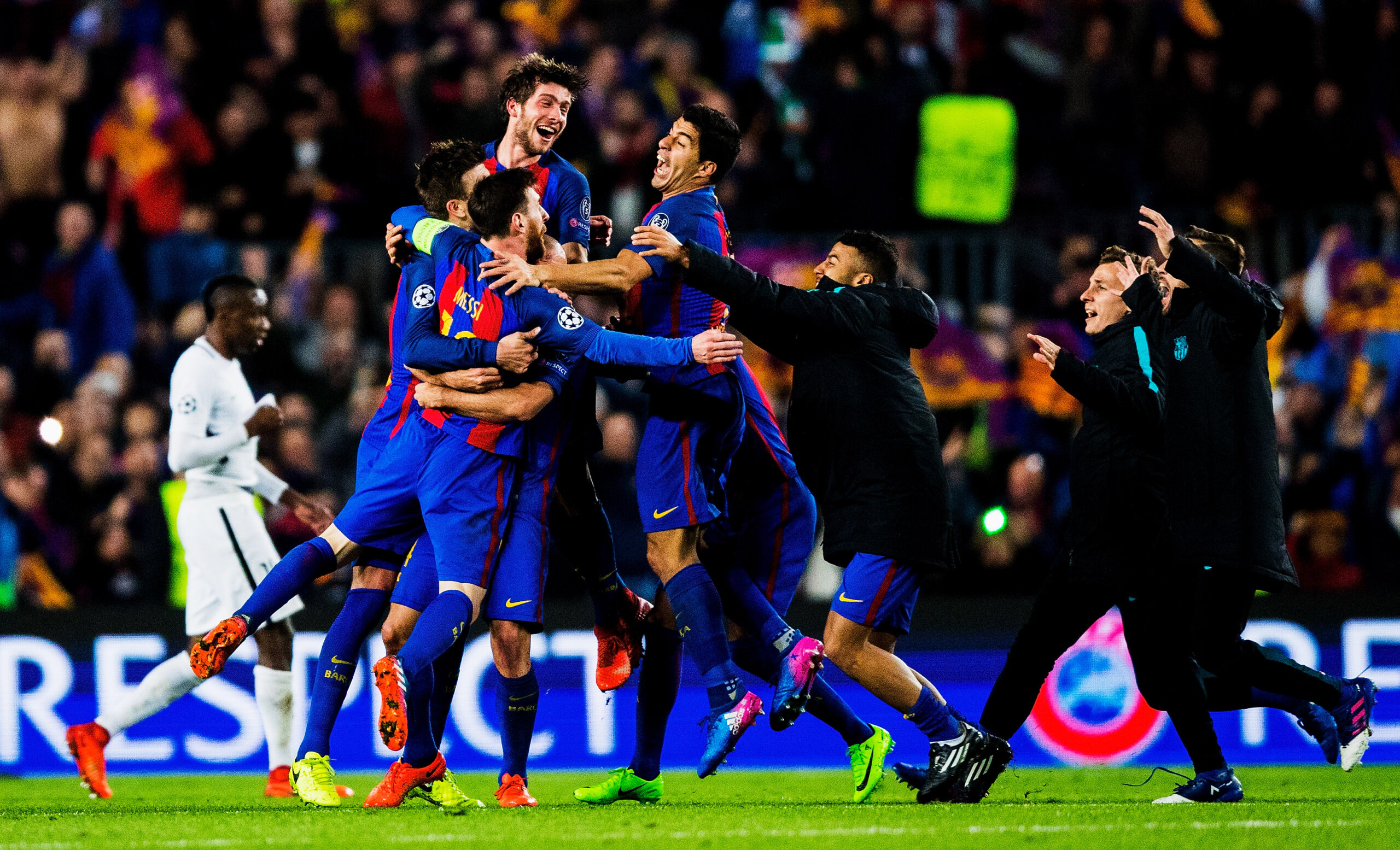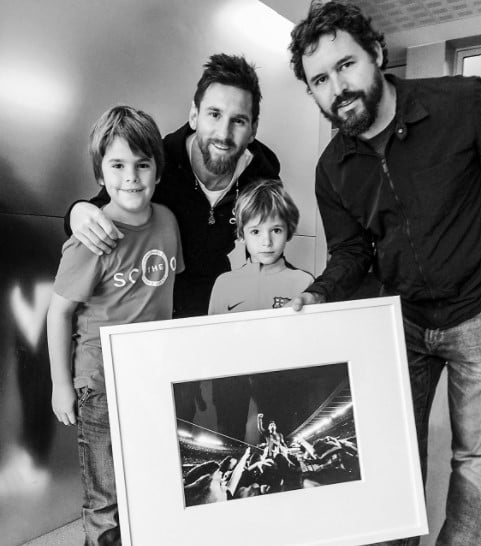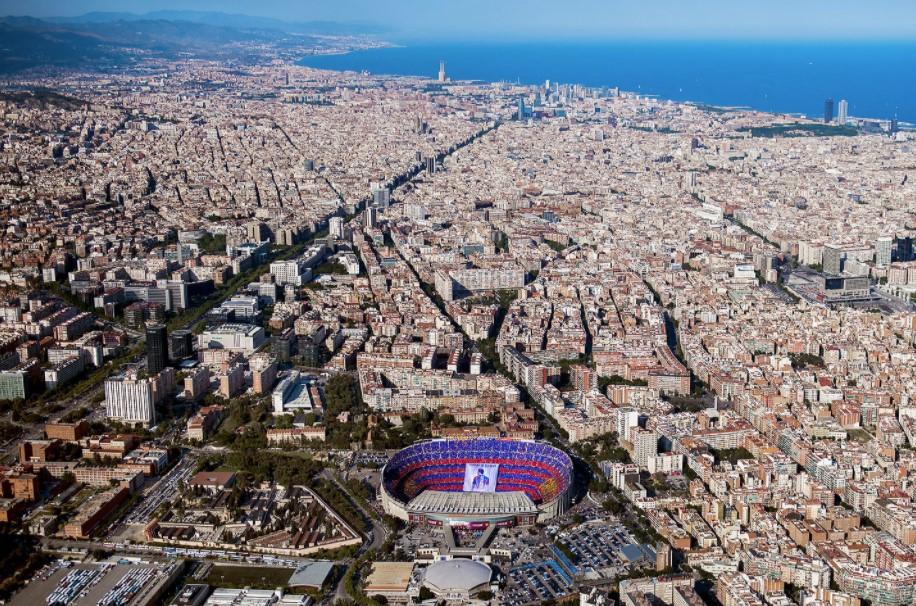“The most incredible part of the whole story of the photo is that, in a stadium with 90,000 people, 300 media outlets accredited, 90 professional photographers from all over the world, there was just one person who had that moment in the camera,” Santiago Garces tells The Athletic. “None of the TV stations, no other photographer, was shooting the moment that I was. There are some other photos, from the side, where you see Messi jumping up on the fence. But from the perspective I had, there was just one, which was me, nobody else.”
Advertisement
The photograph Garces is describing was taken at Barcelona’s Nou Camp on March 8, 2017, when Paris Saint-Germain visited for the second leg of a Champions League last-16 tie. It quickly became the most viral image in the history of football, with more than four million “likes” on Facebook and Instagram within its first 36 hours online. The image has been seen by countless millions over the almost four years since it was taken.
The shot of Barcelona talisman Lionel Messi celebrating the success of overturning a 0-4 first-leg deficit with a 6-1 “remontada” (comeback) crowned by Sergi Roberto’s stoppage-time winner almost immediately became the iconic image of the biggest and most dramatic fightback ever in the Champions League. It has also captured the strength of the emotional connection that existed between the best player in Barcelona’s history and the team’s most passionate supporters.
“That is the magic of photography,” Garces says. “A millisecond captured by a camera can communicate millions of things.
“As soon as I took it, I knew I had an exceptional photo, I could see it was something special.”
Garces was born a long way from Nou Camp, but has been a “photographer all my life”. He began his career as an assistant to renowned Dutch social documentarian Bob Schalkwijk in Mexico City.
After moving to the Catalan capital in 2000, he worked mostly as a portrait photographer. In 2013 he was contracted by FC Barcelona’s marketing department to produce images to “sell” the club to sponsors and fans all over the world.
That meant taking the official portraits of Messi and company at the start of each season, but also shots of the club’s basketball, handball, indoor football, hockey, women’s football, and youth teams. These images were used in the club’s marketing material and also by its sponsors all around the world, including Nike and Rakuten.
Advertisement
Barcelona had other photographers at each game at the Nou Camp taking pictures of the action, key moments, goal celebrations, substitutions, reactions from managers. Garces’ briefs from the marketing department would be different for each match.
“For Champions League games, UEFA has their own sponsors, so Barca’s sponsors’ names are covered-over inside the stadium,” he explains. “There is more liberty to take photos of players or action from the game, to look for another type of more creative photography. The only must-have in my brief for the PSG game was to take a photo of an enormous fans’ Tifo which came down in the stand, and then images of the play.”
Losing 4-0 in Paris three weeks’ previously had been a big blow for everyone at Barcelona. But Garces says that as the return leg came closer there was a feeling around the club that the tie was not over yet, one which grew after a 5-0 home win over Celta Vigo on the Saturday. So he decided to prepare in a different way than usual, just in case something special happened.
“In the week before the game there was a lot of optimism about a comeback, among the players, in the general atmosphere,” he says. “As a photographer, normally you have your different cameras, and then your mono-pod and your computer. But for this game, I brought just two cameras and one large lens. One with the 300mm lens, very telephoto, for the action of the game. The other had the widest angle lens that exists, the 11-24, which I use to photograph fans in the stand, from very close-up. I wanted to have very light equipment, to be able to move around.”
That proved to be a very good idea.
That pre-game feeling of optimism grew when Luis Suarez made it 1-0 on the night with just three minutes gone. PSG’s nervousness was shown when Layvin Kurzawa scored an own-goal five minutes before half-time, and then a Messi penalty made it 3-0 five minutes after the break.
Garces had already decided to change his position by the pitch, sensing he needed to be ready for something special, and decided to focus on the stadium’s Grada d’Animacio. This is a dedicated area, behind the goal at the north end of the stadium, where younger, louder fans provide a lot of the colour and noise during games.
Advertisement
“The game began ideally, with goals scored early,” says Garces. “For the second half, I decided to position myself behind the goal-line official. It is not normally a very attractive place for photographers as the official is blocking your view of the pitch. But I was much more interested in what was happening behind me, in the Grada d’Animacio, and I was taking photos of a group of fans there during each goal celebration. I thought that if there was a ‘remontada’, then the players would come over close to this area of the stand to thank them. And probably I would get some interesting images with the fans.
“Even after PSG scored, there was a tangible feeling that the comeback was possible.”

Edinson Cavani scored an away goal just past the hour mark, meaning Barcelona needed three more goals.
As the minutes ticked by, that began to look less and less likely. But then Neymar curled in an 88th-minute free kick, and a panicking PSG almost immediately gave away a penalty, which the same player converted. Now Barcelona needed just one more goal. Five minutes into added time, Neymar’s chip into the box was met by Roberto, who guided the ball to the net.
Amid all the pandemonium, Garces sprang into action.
“When Sergi Roberto’s goal went in, the first thing I did was jump up,” he says. “I was using the very long 300mm lens and I did not see who had scored the goal, I thought it had been Gerard Pique. I could see that all the team was running towards one corner, except for Messi, who was running over behind the goal. At that moment, I did not think twice, but took off running myself.
“I had the two cameras with me. As Messi was running towards the fence, I was able to change over quickly, as both were hanging around my neck. I went over, running, shooting as I went, with the very wide-angle lens. I know that lens very well, so within all the chaos and movement of people running onto the pitch, I was able to position myself well, and keep shooting. I was running and shooting without having my eye on the camera lens, so there is a long sequence of images, I would say about 50 photos. Among these, there are three very good ones, including the one which was exceptional.”
Advertisement
The other match-focused photographers automatically followed goalscorer Roberto, who was covered by his delirious team-mates. The TV coverage also concentrated mostly on this group of celebrating players over near the corner flag.
But two of the night’s protagonists, Messi and Garces, had gone in a different direction…

“There was a UEFA security camera recording everything in 360 degrees,” Garces says. “In that recording, you can see me running, taking the photo. Somebody knocked over that camera, but it kept recording. You can see exactly the moment when I see that I have the photo of Messi. I immediately took out the memory card and sent it via my telephone to the club, so that they could publish it on social media. You can see from my face in this video that I knew I had done something special.”
Barca’s social media team also realised quickly they had an exceptional photo, even if it took a few minutes for everybody to see it properly.
“The first thing they did was publish it on Instagram, in a square format, badly cropped, and with a filter,” Garces says. “So people thought that somebody had taken the photo with their mobile. But a few minutes later the club published it on Twitter, the original that I sent them. And it began to circulate everywhere, and went viral.”
At first, though, the club published the photo without including Garces’ name.
“People started to ask who had taken the photo,” he says. “When I was still on my way home, my phone began to buzz. Somebody had mentioned who had taken it, and there were already people who wanted to interview me. That night I did some interviews on the radio. The following day, people from the club rang me to tell me that the numbers on social media had never been seen before, that it had broken all the records for a viral photo.”
Advertisement
Messi and his family were also delighted with the image.
“People very close to Leo called me to congratulate me about the photo, and said it was a photo that defined his career,” Garces says. “The club organised a meeting so I could make him a gift of the photo. That was the only thing I asked for. It was a very simple but emotional moment. We talked about it for a moment, I told him how crazy it had got, how far the photo had gone. He laughed and I handed it over. He signed another copy for me, which I have hidden away in a safe!”

After the image went viral, some pointed out that the real driving force behind the “remontada” was in fact Neymar.
“There were others who said that this was not Leo’s best game, that he had taken too much credit,” Garces says. “Later, there was a BBC article saying that probably this photo was the reason that Neymar left Barca.”
It was also not long before Garces himself departed from the club.
Most of Garces’ fellow photographers who work at the Nou Camp every week were happy for him. However, he says that professional rivalry coloured the reactions of some colleagues.
“The following day I had messages of congratulations from some of the agency photographers,” he says. “Others congratulated me at the next game when we saw each other. Others who were not very happy at all that I had taken that photo. There is always rivalry. We photographers always want to have the best photo. Colleagues who were there that day in the stadium told me, ‘Santi, we have some great shots, of Neymar, of Sergi Roberto, of everyone’. But in the end, that night, the photo that flew around the world was the one of Messi.”
As the weeks passed, Garces went back to work for Barcelona’s marketing department, producing other images that stood out from the work being done by his colleagues.

“Other departments began to know what I could do, not just through this photo, but all the work I was doing,” he says. “I had been very criticised at the start, especially by the other photographers. People asked me what I was doing, that this was not sports photography. But that I had not worked in sports before was an advantage to be able to do all that I did. To be able to see things from a different perspective. For the Messi photo, I had an 11mm lens in my hand. A sports photographer would not normally have that with them at the stadium.”
Advertisement
Garces admits not everybody at the club shared his ideas and when his contract ended in July 2020, it was not renewed.
“My work has always been solid, 100 per cent professional,” he says. “I never produced anything that was not worthy of a club as big as Barca. But I had the bad luck to come up against some people with different ideas. There were two years when the relationships were getting worse. Then came the whole COVID-19 issue and my contract was ending. But with the work I had done for the club, nobody expected my contract not to be renewed.”
Asked for comment on Garces no longer working for the club, a Barcelona spokesperson merely confirmed his contract had not been extended last summer.
“Garces did work for the club, as an external contractor of the marketing department, and his contract was not renewed when it ended,” the club source said.
Under Garces’ contract with Barcelona, the club retains the rights to all photographs he took while working for them, which he accepts is normal practice.
“All the photos I have taken for Barca, including the others in the sequence of the famous Messi photo, are all Barca’s commercial property,” he says. “And in return, I got paid my monthly salary. So the famous photo is included in that. Barca, obviously, got the better of that transaction. I am not complaining though, I never asked for anything more. This photo belongs to the history of football, more than anything else. The only right I have is to be proud that I took it.”
Since leaving his role with Barcelona, Garces has focused on the portrait work he has always done. He also collects vintage and anonymous photos, mentors younger photographers and is working on a collection to be exhibited back home in Mexico.
“Barca as a club, as fans, as a team, as everything, gave me the best,” he says. “I had the bad luck to be there at the worst possible moment.”
Advertisement
Garces says he will be back at the Nou Camp on Tuesday, covering PSG’s visit for another Champions League last-16 tie. It is a first leg this time, for another client.
A lot has happened during the four years since the “remontada”, but the man who took the most iconic photo in Barcelona’s history says his life has not really been affected by the experience.
“Personally, the iconic Messi photo did not change too much,” Garces says. “The first thing that happened was that they finally gave me a parking space inside the stadium. The person who organised the parking got to know me through the photo, and I asked him for a spot so I would not have to carry all my cameras and gear so far. The other thing that happened was that it led to me leaving the club.
“In that sense, it changed my life, but in the day to day, very little. I still take photos every day and do things as normal.”
(Top photo: Santi Garces / FCB)
IG: @snapkiller
www.santiagogarces.com
